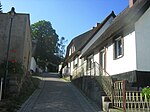Świnoujście

Świnoujście (Polish: [ɕvinɔˈujɕt͡ɕɛ] ; German: Swinemünde [ˌsviːnəˈmʏndə]; Low German: Swienemünn; all three meaning "Świna [river] mouth"; Kashubian: Swina) is a city in Western Pomerania and seaport on the Baltic Sea and Szczecin Lagoon, located in the extreme north-west of Poland. Situated mainly on the islands of Usedom and Wolin, it also occupies smaller islands. The largest is Karsibór island, once part of Usedom, now separated by the Piast Canal dug in the late 19th century to facilitate ship access to Szczecin. Świnoujście directly borders the German seaside resort of Ahlbeck on Usedom, connected by a street and 12 km (7 mi) of beach promenade. Since 1999, Świnoujście has been a city with powiat rights (Polish: miasto na prawach powiatu), within West Pomeranian Voivodeship. The city lies in the geographic region of Pomerania and had a population of 41,516 in 2012. Świnoujście is one of the most important areas of the Szczecin metropolitan area. The Świnoujście LNG terminal, opened in 2015, is located in the city. In 2023, the underwater Świnoujście Tunnel connecting the islands of Wolin and Usedom was opened. Despite its relatively small population, Świnoujście is Poland's ninth-largest city by area.
Excerpt from the Wikipedia article Świnoujście (License: CC BY-SA 3.0, Authors, Images).Świnoujście
Henryka Sienkiewicza, Świnoujście Dzielnica Nadmorska
Geographical coordinates (GPS) Address Nearby Places Show on map
Geographical coordinates (GPS)
| Latitude | Longitude |
|---|---|
| N 53.916666666667 ° | E 14.25 ° |
Address
Henryka Sienkiewicza 7
72-600 Świnoujście, Dzielnica Nadmorska
West Pomeranian Voivodeship, Poland
Open on Google Maps









